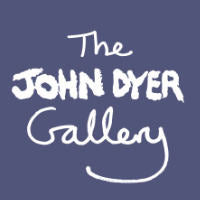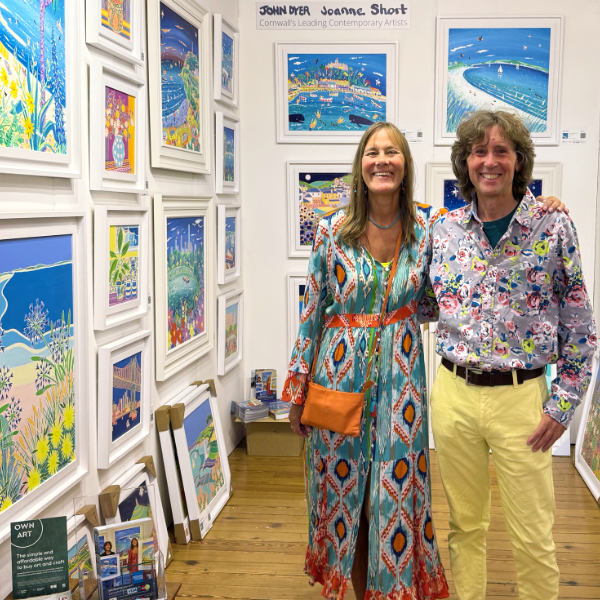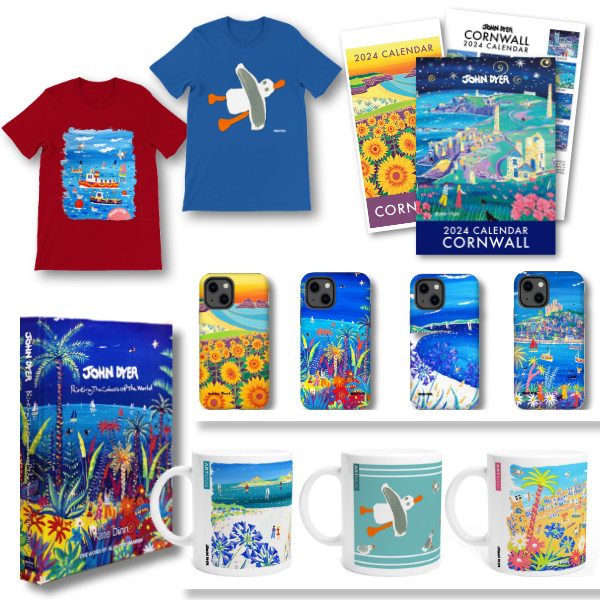Christmas Catalogue Exhibition Paintings Now Available | Private View December 6th in St Ives!
Christmas Catalogue Exhibition Paintings Now Available | Private View December 6th in St Ives!
Invest in British Art from Cornwall's Leading Artists | Free Worldwide Delivery
JOHN DYER
Original Paintings
New paintings available to buy online now by Cornwall's best loved artist.
JOANNE SHORT
Original Oil Paintings
New paintings available to buy online now by Cornwall's acclaimed colourist painter.
TED DYER
Original Oil Paintings
New paintings available to buy online by Cornwall's best known impressionist artist.
All Original Paintings
View all of the new original paintings that we have available to buy online now in our online gallery.
The ones you missed
View all of the recently sold original paintings by our Cornish artists John Dyer, Ted Dyer and Joanne Short.
Cornwall Art Prints
Museum-quality prints. Framed, Unframed, Signed & Wall Art Posters
Christmas Exhibition St Ives 2024
Private View: 6th December 6pm to 8pm
Exhibition continues: 7th - 8th
Summer Collection 2024
Online exhibition of new paintings by John Dyer & Joanne Short.
Easter Exhibition St Ives 2024
New paintings by John Dyer & Joanne Short in the historic Porthmeor Studios in St Ives.
Explore our Previous Exhibitions
Enjoy exploring our previous exhibitions and discover amazing paintings.
Art Collectors Club.
Enjoy 5% off your first order, regular offers, exclusive exhibition invitations and artist and gallery updates in our monthly email newsletter.
John Dyer was appointed as an official artist in residence in the South West for the United Kingdom's Darwin 200 celebratory year.

Brian Stewart and Falmouth Art Gallery were also responsible for a year of exhibitions, events and a community education programme dedicated to celebrating another notable bicentenary which had strong associations with Falmouth. ‘The most important journey of the nineteenth century – perhaps the most important journey ever – was undertaken by Charles Darwin (1809–1882) on the Beagle between 1831 and 1836,’ said Brian, referring to Darwin’s famous voyage during which the wildlife he encountered, especially in the Galapagos Islands, was instrumental in the formulation of his ideas about natural selection, leading to his Theory of Evolution. ‘Little known is the fact that throughout his voyage Darwin sent specimens back to this country via the Packet mail service which was still based at Falmouth. The Beagle finally returned to Falmouth on 2 October 1836, and so the town is central to the Darwin story and the publication of The Origin of Species, both of which are celebrated worldwide.’
Explore our main art collections to find perfect original paintings, limited edition signed prints, open-edition prints, wall art prints and posters & artist designed gifts.
N.B. If you don’t see your confirmation email shortly, please check your spam or junk folder.
We love John’s pictures of France. We already have an original of Nice but bought this poster as it brings back so many wonderful memories.
Superb communication and attentiveness from gallery. The poster is of course wonderful.
Love this print - bright, sunny and makes one feel warm and happy!
Delivery was all easy and straightforward. Many thanks.
The print is even better in real life. It’s printed on beautiful quality paper which makes the colours really pop and the painting itself is simply charming. It brings so much joy to us. We love it! Thank you
A lovely art print bought as a memory of our holidays on the beautiful Isles of Scilly.
The frame is very well made and displays the art print beautifully. Ordering from John Dyer Gallery was simple and delivery swift. I would not hesitate to order from them again.
Thank you so much for the amazing customer service, and most beautiful painting of our favourite place
Absolutely beautiful painting. So thrilled with it. Completely amazing service: beautifully packaged, framed and safely delivered really quickly.
Lovely picture, bought 3 after our recent trip to Cornwall. Already thinking of getting more.
Have walked this coastal path from St Agnes to Chapel Porth and back countless time. I am now pleased that this fabulous print is the first thing I see every morning. Beautiful, happy colours. Nice frame. I’m now planning of ordering one of Mount’s Bay by same artist.
Such a vibrant, pretty piece. I visited Fowey Harbour recently and was looking for a small keepsake to have with me back in the U.S. Shipping abroad was seamless and I received this item quite quickly. I've had many compliments since putting this on my phone and am happy to be reminded of a wonderful trip to a magical place this summer.
As always professional , efficient and prompt .
We have been coming here for 27 years together. This is our place especially during lockdown. John has captured our place beautifully. I have many of John’s prints, always in my birthday, so this one for June is 😍 perfect. They always make me smile, colourful, fun and look perfect in our home
I found the whole experience flowed from start to finish. The customer service was exceptional, they couldn’t do enough for me. This is the kind of first rate service I would expect from such a professional artist. Thank you.
Lovely,bright and colourful ready to hang.
Bought back lovely memories.
Posted promptly too.
Thank you.
I have loved John Dyers work for many years. I have some prints at home and at work.
Gorgeous, vibrant colours. Reminds me of many happy evenings at the Minack when growing up in Cornwall. Special memories.
great service. Thank you.
I purchased “Bathing Belles” to add to 2 other John Dyer original paintings collected over the years .
We decorated our house and removed another trio of prints , so were hoping to find something suitable at John’s latest exhibition.
We were not disappointed . The colours are vivid and the painting has elements of my childhood : a trip on the Enterprise boat , snd swimming in the sea . There is also a signature seagull (oh how I love those seagulls !!) a chough , a puffin and a friendly seal . I like the play on the words in the title, with bluebells in the foreground .
The off white frames complement the colour palette perfectly .
I was extremely impressed on how quickly the painting was delivered after the exhibition - I had expected to wait at least a couple of weeks , but within days it was with me . As always it was packaged very carefully .




